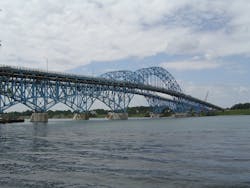The Grand Island Bridges carry I-190 over the Niagara River between Tonawanda, Grand Island and Niagara Falls, N.Y. The two sets of twin truss arch bridges were opened in 1935 and 1962 (south end bridges), and 1935 and 1965 (north end bridges). All four structures are currently owned and operated by the New York State Thruway Authority (NYSTA).
In late 2008 the New York District Office of American Bridge was awarded a $48 million contract by the NYSTA for the rehabilitation of the South Grand Island Bridges (SGIB). American Bridge has been a leading builder of complex structures since it was founded in 1900. Each of the twin south structures is comprised of a truss arch bridge with a steel through-arch in the center span, along with simple girder span approaches.
Included in this first phase of rehabilitation was replacement of the existing deck slab on the northbound structure with a precast Exodermic deck system which took place during nighttime closures between the hours of 9 p.m. and 6 a.m. Traffic on the northbound bridge was diverted to the southbound structure during work periods, and both structures were completely opened to traffic during non-work hours. Because of the nearly 3,000-vehicles-per-hour traffic volume during peak periods, the NYSTA imposed strict penalties for late opening that could reach $125,000 for a single occurrence. Needless to say, the contractor did not have many mornings with a delayed opening.
American Bridge typically worked two crews at separate locations on the bridge. During the closure, one crew worked to install up to six transverse panels between stringers on the truss section while another worked to install up to four longitudinal panels between floorbeams on the girder spans. In total, the crews were able to set a little over 2,000 sq ft of new bridge deck per night and completed the roughly 90,000-sq-ft project ahead of schedule. After installation of the new deck panels the contractor was allowed to utilize a full weekend closure to diamond-grind the deck and install a ¾-in.-thick polyester polymer concrete overlay to seal the deck panels and closure pours.
Chris Hulse, NYSTA project engineer, said, “Things moved along better than expected and we are confident the precast deck was the best choice. The deck system has proven to be a very reliable product for the NYSTA. It’s durability in combination with a light weight design to reduce dead load on the structure should be valuable in extending the life of the bridge.”
The North Grand Island Bridges (NGIB), nearly identical to the SGIB structures, will also undergo a similar rehabilitation starting sometime in 2013 or 2014. Bergmann Associates was the consulting engineer responsible for scoping and design of the SGIB rehabilitation and also is under contract with the NYSTA for final design of the NGIB rehabilitation project, which also will include overnight deck replacement utilizing precast Exodermic deck panels.



